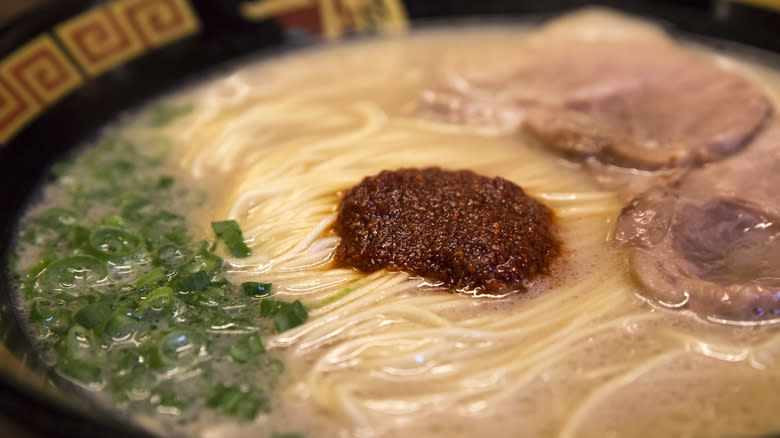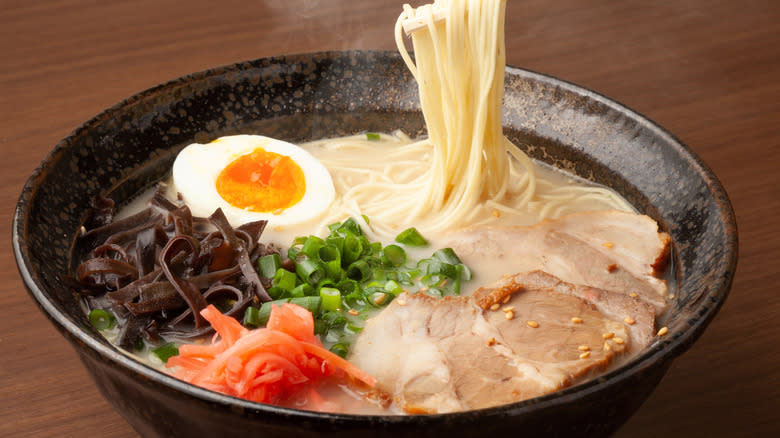The Important Difference Between Tonkatsu And Tonkotsu

If you're not familiar with Japanese cuisine — or even if you are — it's easy to confuse tonkatsu and tonkotsu. Just one letter apart, the words seem like they could refer to different variations of the same dish. You might even assume that they're the same word with different spellings.
In truth, tonkatsu and tonkotsu are very different. The main similarity is that they both feature pork: Ton translates to pig or pork. But the dishes differ: Tonkatsu refers to crispy fried pork cutlets, while tonkotsu is a type of ramen made from bone broth. The katsu in tonkatsu comes from the Japanese word katsuretsu, meaning cutlet, and the kotsu in tonkotsu means bone. So, the words literally translate to pork cutlet and pork bone — apt descriptions of each dish. Still can't keep them straight? Think of the second "o" in tonkotsu as a steaming bowl of ramen.
But despite the clear differences, both tonkatsu and tonkotsu provide insight into the rich history of Japanese cuisine. Both dishes are based on recipes that originated elsewhere, a testament to the way that the end of Japan's isolationist period shaped the country's culinary culture. Neither dish dates back more than 130 years: You can still eat at the restaurants where they originated. But over time, each has taken on a life of its own — evolving into new forms and becoming part of Japan's rich culinary identity.
Read more: Restaurant Foods That Always Taste Better Than What You Make At Home
What Is Tonkatsu?

Tonkatsu refers to pork cutlets coated with breadcrumbs and deep-fried. Cooks season the cutlets, typically made from fillet or loin, with salt and pepper. Once the meat is seasoned, it's dipped in egg, and coated in breadcrumbs before being fried in oil. While many Western dishes intentionally use stale breadcrumbs, tonkatsu uses panko. The soft, fresh, Japanese-style breadcrumbs, used for dishes like tempura, give the breading a light, crispy texture. Tonkatsu is typically served with shredded cabbage and a Worcestershire-based sauce; you might get rice, miso soup, or pickled vegetables along with your cutlets, too.
Tonkatsu is a mash-up of Japanese and Western cuisine. While it's often compared to German schnitzel, tonkatsu was inspired by the French c?telette de veau, veal cutlets pan-fried in breadcrumbs. It debuted at Rengatei — one of the first Western-style restaurants in Japan — in 1899.
While Rengatei still serves cutlets based on the original recipe, tonkatsu has spawned many variations. In Japan, the most popular is katsu curry, which features Japanese-style curry topped with tonkatsu. Tonkatsu has also traveled back to Europe, where katsu curry found popularity in the U.K. There, the word katsu has become a catch-all term for Japanese curry flavoring, cropping up on packages of chicken soup and vegan hamburgers. But no foreign interpretation can beat Japan's own: Deep-fried katsu KitKats.
What Is Tonkotsu?

Tonkotsu refers to a type of ramen made with thick, creamy pork bone broth. While Western-style broths are generally simmered, tonkotsu is cooked at a roaring boil for hours. The unrelenting heat breaks collagen in the bones down into gelatin, which gives the broth its characteristic texture.
Tonkotsu is also called Hakata ramen, after the Fukuoka ward where it was invented in 1937. But the cloudy tonkotsu we know today was born in 1947 when shop owner Katsumi Sugino-san forgot about a boiling pot of broth. Hours later, he discovered that the overcooked broth had turned white, milky, and delicious. He later opened the restaurant Nankin Senryo, which his descendants still operate.
Tonkotsu is typically topped with sliced barbequed pork and chopped green onions (although, confusingly, it is sometimes topped with tonkatsu, as in the first picture in this article). Other ingredients like eggs, pickled ginger, and mushrooms are popular, but kept to a minimum to emphasize the broth. This minimalist approach once extended to the broth, too. The version found at Nankin Senryo, based on the original recipe, has a milder, subtler flavor than the tonkotsu found in most ramen shops today.
Tonkotsu uses thin, delicate noodles. Traditionally served undercooked, now many restaurants let you choose how firm you'd like them. Ordering soft noodles might get you a side-eye from your server, though — it's like ordering well-done steak. That's because the thin noodles get mushy if you leave them in the hot broth for too long.
Tonkatsu Has Roots In Western Cuisine

Rengatei debuted tonkatsu during the Meiji period, which lasted from 1868 to 1912. It was an era of radical social change, and tonkatsu was a sign of the times. For 1200 years, the Japanese government had banned the consumption of meat. It wasn't until Emporer Meiji came to power in 1868 and ended Japan's long-held isolation policy that the ban was struck down. In an effort to Westernize the country and promote nutrition, the emperor began actively encouraging Japanese people to eat meat.
By the time Rengatei opened in 1895, people had started warming to the idea. Still, cooks at Rengatei had to adapt c?telette de veau to Japanese tastes. Pork was cheaper than veal, and less objectionable: Previously, eating meat from cows had been considered particularly taboo. Rather than pan-frying cutlets dusted with stale bread crumbs, cooks took cues from tempura. They coated the cutlets in soft, fluffy panko crumbs and deep-fried them, then placed them on a bed of shredded cabbage and topped them with another popular Western import — Worcestershire sauce.
While tonkatsu may have originated from Western cuisine, no one would mistake it for seiyō ryōri, the Japanese term for authentic European food. Instead, it's an example of yōshoku, Western food modified to fit Japanese tastes. Yōshoku often bears little resemblance to actual Western food. It tends to be more reflective of Japan's unique history, culture, and culinary traditions.
Tonkotsu Has Roots In Chinese Cuisine

Given ramen's popularity today, it's easy to assume that Japanese cooks have been making it for centuries. It might come as a surprise to learn that ramen is a fairly new part of Japanese culture.
After Japan ended its isolation policy, Chinese traders jumped at the chance to do business with the new market. They settled in Yokohama and brought recipes with them. Soon, the city was home to a Chinatown, where shops sold Chinese-style noodles. The noodles proved to be a hit among workers looking for a cheap, filling meal. Eventually, a variation of the dish's Cantonese name — la mian, or stretched-out noodles — caught on among Japanese customers. Over the 20th century, ramen went from being a food stall standard to a global phenomenon, a favorite in dorm rooms and Michelin-star restaurants alike.
Just as cooks adapted c?telette de veau and la mian to Japanese tastes to create new dishes, both tonkotsu and tonkatsu have taken on a new life abroad. London-based tonkotsu ramen chain Shoryu adapted the soup to British tastes — and then brought the new variations back to Japan with a Fukuoka location. In Korea, chefs adapted tonkatsu into dongaseu, and later fish-based Saengseonkkaseu. As the dishes continue to spread, new variations will doubtlessly emerge to create fresh connections across history and culture.
Read the original article on Tasting Table.